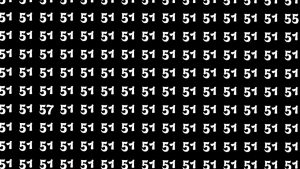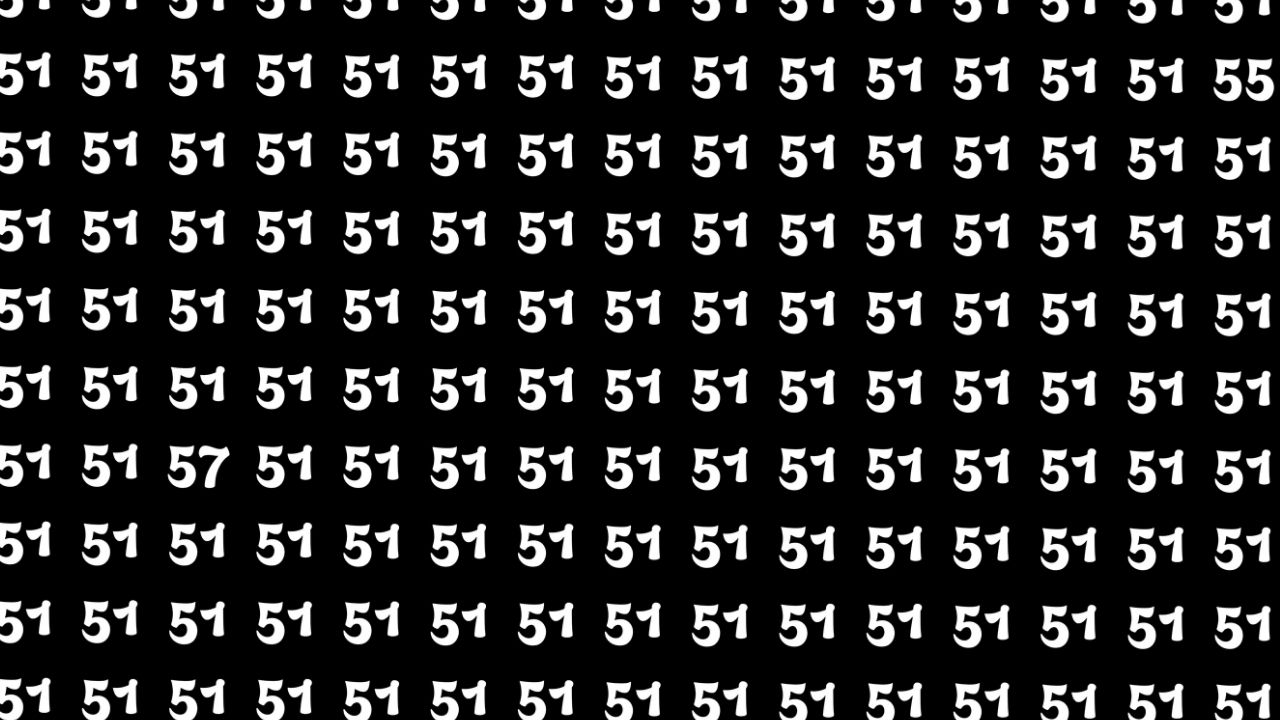G’day, mates! Have you ever stared at something so long your eyes started playing tricks on you? That’s exactly what’s happening with this mind-boggling Australian optical illusion that’s got the internet scratching their collective heads.
The deceptively simple image appears ordinary at first glance. Yet somewhere within its clever design lurks the elusive number 5, hidden with such artistic cunning that thousands have failed to spot it.
Created by Australian visual artist Melody Jasper, this particular illusion has spread like wildfire across social media platforms. The genius behind this visual puzzle lies in its simplicity – the number isn’t technically invisible, just camouflaged in a way that tricks our brains.
“I wanted to create something that makes people look twice,” explains Jasper, who designed the illusion during lockdown in her Melbourne studio. Her creation has since become one of the most shared Australian optical illusions of the year.
The Science Behind the Illusion
Our brains are fascinating organs that sometimes work against us when processing visual information. This particular type of visual trickery exploits how our visual cortex functions.
When we look at an image, our eyes send information to our brain, which then attempts to make sense of what we’re seeing. The brain often takes shortcuts based on past experiences and expectations.
In this illusion, the number 5 is typically hidden using clever color gradients and strategic positioning. The brain focuses on more obvious elements while missing what’s hiding in plain sight.
Dr. Lisa Nguyen, a cognitive psychologist at the University of Sydney, explains that these illusions highlight the limitations of human perception. “What we think we see is often influenced by what we expect to see,” she notes.
Why Some People Spot It Immediately
Interestingly, about 20% of people can see the hidden 5 almost immediately. This ability may be related to certain cognitive strengths in visual processing.
Those who spot the number quickly often have backgrounds in visual arts, design, or professions requiring keen attention to detail. Their brains are trained to look beyond the obvious.
A study conducted at the University of Melbourne found correlations between puzzle-solving abilities and specific thinking patterns. People who regularly engage with brain teasers develop neural pathways that enhance pattern recognition.
Children also tend to perform better on this particular illusion than adults. Their minds haven’t yet developed the same filtering mechanisms that cause adults to miss subtle details.

Tips to Finally See That Hidden 5
If you’re still squinting at the image with no luck, don’t worry – you’re in good company. Here are some practical techniques that might help you spot that elusive number.
Try looking at the image from different angles or distances. Sometimes holding your phone at arm’s length or viewing the screen from the side can reveal hidden elements.
Another effective approach is to unfocus your eyes slightly, similar to how you’d view those popular Magic Eye puzzles from the 90s. This technique can help bypass your brain’s filtering mechanisms.
Taking a short break before looking again can also help. The brain sometimes needs a reset button when it gets stuck in a particular way of viewing something.
The Psychology of “Aha!” Moments
That instant when you finally spot the hidden 5 triggers what psychologists call an “aha moment” – a sudden insight that feels remarkably satisfying. This cognitive experience releases dopamine in the brain.
These eureka moments are addictive, which partly explains why optical illusions and puzzles remain so popular. The frustration of searching makes the discovery even more rewarding.
Researchers at Queensland University have documented the emotional journey people experience with challenging visual puzzles. Initial curiosity gives way to frustration, then determination, and finally elation.
“It’s similar to the satisfaction of solving a difficult crossword or finding the last piece of a jigsaw puzzle,” explains social psychologist Dr. James O’Connor. The experience creates a brief but powerful mood boost.
Creating Your Own Hidden Number Illusions
Inspired to try your hand at creating similar puzzles? Many Aussies have embraced this creative challenge during recent lockdowns, sharing their homemade illusions online.
The key to an effective hidden number illusion lies in working with complementary colors and strategic use of negative space. The number should be technically visible but not immediately obvious.
Digital tools like Photoshop make this easier, but even hand-drawn illusions can be effective. Some creative types have used coffee stains, watercolors, or even arrangements of household objects.
Local art teacher Sophia Wilson has incorporated these activities into her curriculum. “Students love creating puzzles for their mates to solve,” she says, noting the educational benefits of such creative exercises.
The Social Media Phenomenon
The “Find the 5” challenge exemplifies how optical illusions function as perfect social media content. They’re interactive, shareable, and trigger emotional responses – the holy trinity of viral content.
Comment sections fill with a mixture of triumphant “Found it!” declarations and frustrated demands for hints. This engagement is precisely what platform algorithms reward with increased visibility.
Australian content creator Tim Blackwell’s TikTok video challenging viewers to find the hidden 5 garnered over 3 million views in just 48 hours. The simplicity of the challenge belies its engagement power.
Marketing professionals have taken note, with several Australian brands incorporating similar visual puzzles into their advertising campaigns. These ads hold attention longer than traditional marketing approaches.
Similar Mind-Bending Illusions
If you’ve enjoyed the hidden 5 challenge, Australia has produced several other notable optical illusions worth investigating. Each exploits different aspects of how our brains process visual information.
The “Spinning Dancer” illusion, adapted by Sydney-based digital artist Ky Henderson, appears to rotate in different directions depending on which visual cues your brain prioritizes.
Queensland’s famous “Beach or Door” image confounds viewers by presenting an ambiguous scene that can be interpreted in two completely different ways. The interpretation often reveals fascinating aspects of individual perception.
Artist collective Glitch Gallery in Perth specializes in digital illusions that seem to move despite being static images. Their works exploit how our visual system processes contrast and peripheral motion.
The Cultural Impact of Visual Puzzles
Throughout human history, optical illusions have played significant cultural roles. Aboriginal Australian art often incorporates elements that can be viewed from multiple perspectives, revealing different stories.
European medieval manuscripts sometimes contained hidden images and words, serving both decorative and symbolic purposes. These were early examples of the human fascination with visual puzzles.
Today’s digital illusions continue this tradition while reaching global audiences instantaneously. They represent a unique intersection of art, psychology, and shared experience.
Anthropologists note that puzzles and illusions serve as cultural touchstones – shared challenges that transcend language barriers and bring diverse groups together in common frustration and delight.
Optical Illusion Solved

Frequently Asked Questions
Why can’t I see the hidden number 5? Your brain might be focusing on more obvious patterns and filtering out what it considers background elements.
Do some people have an advantage in spotting hidden images? Yes, individuals with backgrounds in visual arts and those who regularly solve puzzles often perform better.
Can I improve my ability to see optical illusions? Absolutely! Regular practice with various types of visual puzzles strengthens neural pathways involved in pattern recognition.
Are children better at seeing this particular illusion? Many studies suggest children often outperform adults because their visual processing systems are less influenced by expectations.
Why do we feel so satisfied when we finally spot the hidden element? Finding the hidden element triggers dopamine release in the brain, creating a pleasurable “aha moment.”
Beyond Entertainment: Practical Applications
While these illusions are undeniably fun, they serve important scientific and practical purposes as well. Researchers use similar visual tests to study cognitive processing and attention mechanisms.
Medical professionals sometimes employ specialized versions to assess visual perception in patients with certain neurological conditions. These provide valuable diagnostic information.
In educational settings, optical illusions help demonstrate key concepts in psychology, neuroscience, and visual arts. They make abstract ideas about perception tangible and engaging.
Workplaces have incorporated similar puzzles into team-building exercises, as they reveal different problem-solving approaches among colleagues. Such activities promote collaborative thinking.
The Future of Optical Illusions in Digital Media
As technology evolves, so too does the sophistication of optical illusions. Virtual and augmented reality platforms are creating entirely new categories of perceptual puzzles.
Interactive illusions that respond to viewer movements represent the cutting edge of this art form. Australian developers at SydneyTech have pioneered several such immersive experiences.
Neuroscientists predict that studying how people interact with these new forms will yield important insights into consciousness itself. The humble illusion has become a window into understanding our minds.
Meanwhile, the classic “hidden number” format continues to charm new generations. Its simplicity and accessibility ensure its place in the pantheon of visual puzzles that have captivated human imagination.
Why We Can’t Resist a Good Puzzle
The hidden number 5 illusion taps into something fundamentally human – our love of discovery and problem-solving. From ancient caves to modern smartphones, we’ve always created and sought out such challenges.
Next time you find yourself staring at a puzzling image, remember you’re participating in an activity that connects you to countless others across time and space. There’s something profoundly unifying about shared perplexity.
Whether you spotted the 5 immediately or you’re still searching, the journey itself provides both entertainment and a tiny glimpse into the fascinating workings of your own mind.
So keep looking for that hidden 5 – and when you find it, enjoy that little rush of triumph. After all, life’s simple pleasures often hide in plain sight, just waiting for us to adjust our perspective.
